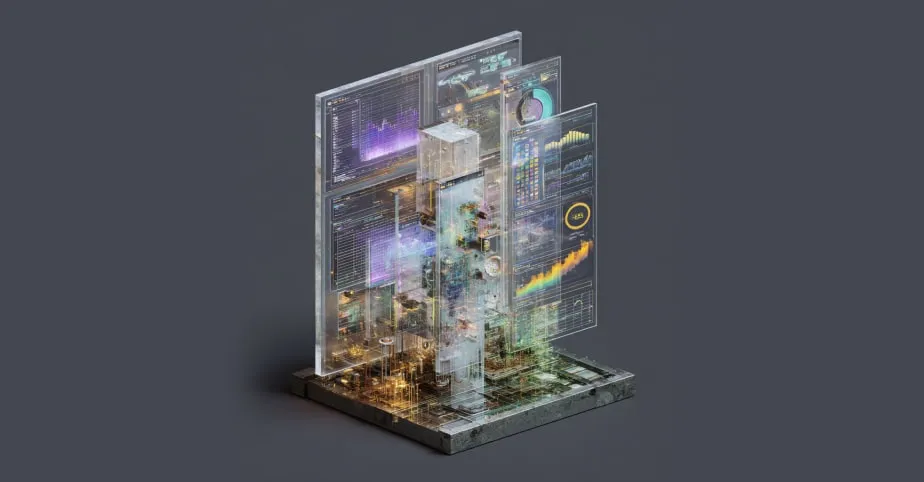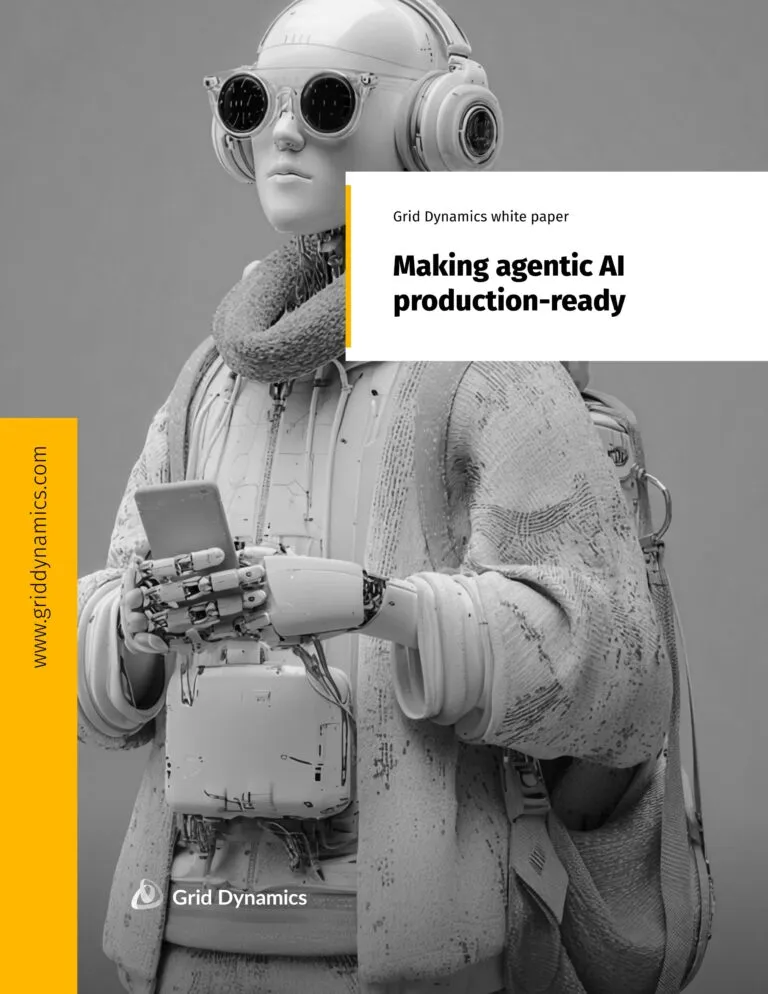Solve the developer productivity paradox with Grid Dynamics’ AI-powered engineering advisor
Jul 29, 2025 • 5 min read

Today, many organizations find themselves grappling with the developer productivity paradox. Research shows that software developers lose more than a full day of productive work every week to systemic inefficiencies, potentially costing organizations with 500 developers an estimated $6.9 million annually. This lost productivity, coupled with the staggering $2.41 trillion estimated cost of poor software quality in the U.S. alone, creates an urgent need for smarter solutions.
Yet many businesses still rely on outdated metrics like lines of code or commit frequency to gauge performance. These measures often fail to reflect real effectiveness and can even encourage counterproductive behavior. As Goodhart’s Law warns: “When a measure becomes a target, it ceases to be a good measure.” It’s time to move beyond simplistic indicators and adopt a more holistic, AI-driven approach to engineering excellence.
What if you had an intelligent partner to help you navigate this complexity? Not just another dashboard, but an AI-powered system built on a Measurement-Driven Improvement Methodology that not only presents data but guides you with actionable, AI-powered advice?
Meet your AI-powered engineering advisor
We’re excited to introduce the SDLC Control Tower, an AI-powered engineering advisor designed to help your development teams unlock real productivity, reduce waste, and elevate software quality at scale.

The SDLC Control Tower can be implemented for your ecosystem and seamlessly integrates with leading frameworks like DORA, SPACE, and Flow Metrics, which track how value moves through your development process from idea to delivery. Combined with our proprietary taxonomy and AI-driven value metrics, the system delivers context-aware insights tailored to your organization, fueling continuous improvement across your software development lifecycle.
See the SDLC Control Tower in action
Watch the demoGo beyond dashboards, get AI-driven guidance for systemic improvement
The AI Advisor understands that metrics are for illuminating system and process health, not for penalizing individuals. It actively analyzes your engineering systems to:
- Identify and address delivery bottlenecks: Tired of projects constantly getting stuck? By visualizing how long work actually takes from idea to delivery, your true flow time and cycle time can uncover a common issue that often consumes significant sprint capacity. In fact, only about 10% of a developer’s time is typically spent writing new code. The SDLC Control Tower helps you understand the hidden cost of excessive work-in-progress (WIP) and provides AI-driven guidance to optimize key metrics like flow velocity and deployment frequency (DF).
- Enhance quality monitoring and control: No more relying on gut feelings. Our platform helps you track crucial quality indicators like defect density, the patterns of reworks (and their root causes, be it unclear requirements or technical debt), and the effectiveness of refactoring efforts. Understand your change failure rate (CFR) and work to improve it. For example, the AI Advisor can flag code modules with historically high defect density and recommend targeted testing or refactoring initiatives.
- Optimize development and integration flow: By analyzing metrics like pull request (PR) review time and the insights from output units (intelligent measure of work volume considering complexity), the AI Advisor suggests ways to streamline your code creation and integration processes. This could involve recommendations for automating parts of the PR process or improving documentation to reduce review friction.
- Assess and improve process stability: Alongside CFR, gain insights into your mean time to recover (MTTR), enabling you to bolster environment stability and resilience. The AI advisor might highlight patterns in incidents that contribute to longer recovery times and suggest preventative measures.
- Review workflow patterns for planning & culture: Understand your team’s actual flow distribution. How is effort allocated across features, defects, technical debt, and risks? This is crucial for aligning development capacity with strategic business priorities and fostering a healthy engineering culture, informed by metrics like developer satisfaction/eNPS.
A unified view for everyone down the pipeline
The SDLC Control Tower provides tailored views for every level, ensuring strategic alignment from the CTO to individual teams, all while applying a consistent, holistic measurement approach:
- Strategic & leadership dashboards: Gain clarity on portfolio health, track progress against key objectives, and receive AI-generated recommendations and alerts on metrics like overall flow velocity and portfolio-level technical debt trends.
- Team-specific insights: Dive deep into team-specific DORA metrics (understanding their dual nature as leading and lagging indicators), SPACE framework dimensions (balancing performance with satisfaction and well-being, activity with communication and collaboration, and efficiency and flow), and detailed flow metrics.
- Understanding value, not just volume: The AI Advisor helps you focus on added value, measuring outcomes and business impact rather than just raw output.
Built to empower teams, not monitor individuals
We believe that the goal of productivity measurement is to provide ethical insights into systemic issues, identify bottlenecks, and highlight opportunities for improvement, supporting a culture of continuous learning. The SDLC Control Tower is designed to provide insights into systems and processes, fostering transparency and trust, rather than being a tool for individual performance evaluation.
With AI-powered engineering advice, guided by a profound measurement-driven improvement methodology, you can:
- Drive predictable value delivery: Consistently meet or exceed release targets by understanding and optimizing your flow metrics.
- Enhance speed and stability: Balance all four DORA metrics effectively to improve both delivery velocity and system reliability.
- Improve product quality and reduce waste: Minimize rework and bug-related costs, which can consume up to 50% of development budgets through insights into defect density, rework patterns, and waste ratio.
- Boost team satisfaction and well-being: Identify and address process friction and burnout risks using insights from the SPACE framework.
- Make data-informed strategic decisions: Align team effort with business impact using clear insights into flow distribution and added value.
- Proactively manage technical debt: Quantify the cost of technical debt and make smarter decisions around refactoring and architectural improvements. Like financial debt, technical debt accrues “interest” by slowing future development and increasing maintenance costs. The AI Advisor helps you measure, manage, and reduce such long-term operational costs and risks.
Looking ahead
The challenges of software delivery aren’t going away—but how you solve them can. With Grid Dynamics’ SDLC Control Tower, you’re no longer limited by guesswork, siloed metrics, or outdated dashboards.
Are you ready to move from ambiguous signals to clear, AI-driven insights that drive systemic improvement and deliver tangible business outcomes? It’s time you experienced advanced engineering intelligence.
Contact us to schedule a personalized demo.
Discover how the SDLC Control Tower, grounded in a comprehensive, measurement-driven improvement methodology, can empower your organization to build better, faster, and smarter, together.
Tags
You might also like
Today, agentic AI can autonomously build, test, and deploy full-stack application components, unlocking new levels of speed and intelligence in SDLC automation. A recent study found that 60% of DevOps teams leveraging AI report productivity gains, 47% see cost savings, and 42% note improvements in...
Fortune 1000 enterprises are at a critical inflection point. Competitors adopting AI software development are accelerating time-to-market, reducing costs, and delivering innovation at unprecedented speed. The question isn’t if you should adopt AI-powered development, it’s how quickly and effectivel...
According to Gartner, by 2028, 33% of enterprise software applications will include agentic AI. But agentic AI won’t just be embedded in software; it will also help build it. AI agents are rapidly evolving from passive copilots to autonomous builders, prompting organizations to rethink how they dev...
When it comes to the best web development frameworks, finding the right balance between efficiency, creativity, and maintainability is key to building modern, responsive designs. Developers constantly seek tools and approaches that simplify workflows while empowering them to create visually strikin...
Most enterprise leaders dip their toe into AI, only to realize their data isn’t ready—whether that means insufficient data, legacy data formats, lack of data accessibility, or poorly performing data infrastructure. In fact, Gartner predicts that through 2026, organizations will abandon 60% of AI pr...

For many businesses, moving away from familiar but inherently unadaptable legacy suites is challenging. However, eliminating this technical debt one step at a time can bolster your confidence. The best starting point is transitioning from a monolithic CMS to a headless CMS. This shift to a modern c...
Many organizations have already embraced practices like Agile and DevOps to enhance collaboration and responsiveness in meeting customer needs. While these advancements mark significant milestones, the journey doesn't end here. Microservices offer another powerful way to accelerate business capabil...










